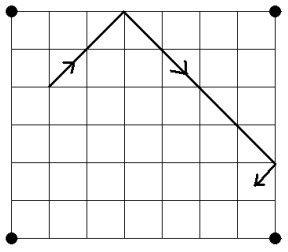Batch 2 - Class 286 - Billiard Reflections
Zoom: send meeting Id and password
Start recording
Preclass Exercise:
- Find the right angled triangle with integral sides and the largest perimeter, with one of the sides measuring 13 units
Attendance: Raghav, Kabir, Shikhar, Ayush, Rhea Chadha, Ryan Chadha, Rohan, Yatharth, Anika, Vansh, Adyant, Ekagra, Mihir, Advay, Aneesh, Siddharth, Tarush, Aarav, Vivaan, Siddhant
Class Notes: (repeat from class 93)
Jokes
- What is the area of a circle
- pi.r^2 - No, "Pie are round, Crackers are square"
- What is the volume of a pizza with radius z and height a?
- pi.z.z.a
Billiard Reflections
A ball is shot from the bottom left corner of, say, a 3x5 billiard table, for instance, at a 45 degree angle. The ball traverses the diagonals of individual squares drawn on the table, bouncing off the sides of the table at equal angles. Into which pocket, A, B, or C, will the ball eventually fall?
.png)
Experiment with tables of different dimensions. What do you notice about those tables that have the ball fall into pockets A, B, C? Test your theories with more tables.
- Instructor Notes: Some kids may start to get to the following conclusions (If not, let them try more and tabulate)
- If n and m are odd, the ball falls in pocket B
- If n is even and m odd, the ball falls in pocket A
- If n is odd and m even, the ball falls in pocket C
- If both n and m are even, the equation is more complex. What is it?
- Must every ball land in either pocket A, B or C? Can the ball return to the start? Can the ball enter an infinite loop and never fall into a pocket?
- Instructor Note: Let kids play with the problem. After some time emphasize on the infinite loop problem. See if kids can get to the conclusion that balls never seem to come back to same path. Why? If balls get into a loop, consider the first cell where they started repeating the path - how do they get there? Can there be a "first" such cell?
- Could the ball enter the same square twice in opposite directions? Which is the first such cell?
- Could the ball pass the same square but along a different diagonal?
- If a ball can't traverse the same path (or reverse), what must eventually happen? What are the maximum possible diagonals the ball can pass through?
- Can it fall back into the lower left corner?
- Color the cells of each table black and red like a checkerboard. What do you notice about the path of a ball across red cells? Across black cells? Imagine a 13x29 table - do not draw. Imagine how a ball will traverse and where it can fall.
- The ball traverses red cells only along the northwest diagonals and black along southwest (or vice versa). How does that help you determine the square the ball can fall into?
- What if we color alternate vertices black and white? What can you deduce about the cells now?
.png)
- Can you start to explain the odd/even pattern now? What happens when n and m are both even?
- Can you take a 4x6 table and analyze the movement of the ball. Can you find an alternate (simpler) board where the movement looks exactly the same?
- With this "reduction", can you devise a rule for even by even table?
- What will a 10x50 table reduce to?
- Did you notice that for our 3x5 table the ball passed through every cell in the table? Is that always true? Can you find a rule that governs this?
- Since ball travels integral table lengths, the number of cells traversed must be multiple of m. Similarly multiple of n. Hence multiple of nm if n and m do not have common factors. But N can anyway not be larger than nm. Hence, if n and m are coprime, then the ball must travel every square.
- If n and m have a common factor (like in even by even tables), then the table is reducible to a smaller table, and hence the ball MUST skip certain cells. Specifically, if d is the GCD of n and m, such that n=ad, and m=bd, then the ball must travel abd cells.
- What happens if the ball doesn't start at a corner but at another point?
- What color grid points does the ball traverse?
- If a ball starts at a corner, where will it end up?
- If n and m are even, and the ball starts on a white cell, what will happen? Think about it in terms of 2x2 cells to reduce the table.

Homework Problem:
- Find the winning strategy for the following game. There are 15 coins in a row. Each player can pick 1, 2 or 3 adjacent coins in her turn. Note that two coins from between which a coins has been removed do not count as adjacent. Then the next player does the same, and so on. Person who picks the last coin(s) wins. Does the first player have a winning strategy? If so, what is it?
- Answer: Pick the middle coin to leave two rows of 7 coins each. Now replicate whatever move the opponent makes to preserve symmetry after every more.
References:
https://www.mathcircles.org/files/ON%20REFLECTION_July%202010_MSRI.pdf (doesn't seem to work anymore)